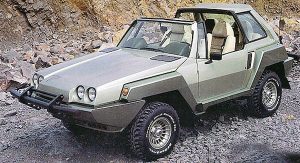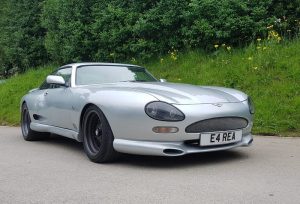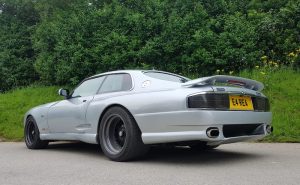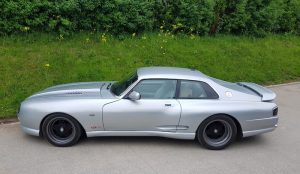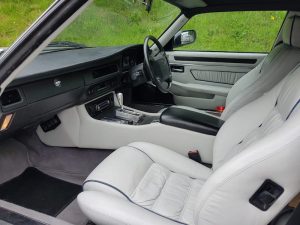UNDERRATED GEMS – THE STORY OF PAUL BAILEY DESIGN
STEVE HOLE tells the story of the very underrated designer, Paul Bailey and the various body conversions he offered in the nineties.
A very talented designer called Paul Bailey flirted on the fringes of the kitcar world in the early nineties, but I bet very few reading this piece will recall him.
In fact, I expect people will think I mean Paul Banham and ‘Bailey’ is a typo. Nope, two different people, two very talented people, but only one of them blazed a trail in our industry and it wasn’t Mr Bailey.
To confuse matters further the two were friends and both released a Jaguar XJ-S-based conversion at roughly the same time. For the purposes of this feature, however, it’s Paul Bailey we are focusing on.
The Bristol-based designer was a former Rolls-Royce aeronautical engineer and car enthusiast. He’d cut his automotive teeth working at a company called Glenfrome in his home city. There he’d get involved with the company’s fine line of stretched, modified and generally outrageous Range Rover-based vehicles. These included six-wheel, six-door stretched delicacies and others that could be used for falconry often in Saudi Arabia, Dubai and the like.
When Glenfrome Engineering went skint he continued to work for that company’s former directors’ father and son Ken and Michael Evans on special Range Rover projects for the Sultan of Brunei. He also worked on the Glenfrome Facet as well as creating an XJ-S conversion stretched by a whopping 10in.
Then, in 1987, Bailey set up PBB (his initials) Design and indulged his passion for car modifying. Among his early conversions were Mercedes-Benz S-Class and SL as well as Rolls-Royces. He particularly welcomed bespoke one-off jobs.
His first ‘proper’ model under the PBB banner was the St Tropez, a very pleasing restyle of the Lotus Esprit, which added aggression and style to the original.
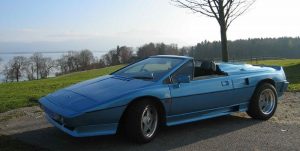
PB ST TROPEZ body conversion for Lotus Esprit. Three sold. Pic courtesy of lotusespritconvertible.de
Bailey’s design saw the roof chopped between the A- and C-pillars, which also involved a new engine cover, convertible roof, revised bumpers and wider wheel arches to incorporate beefier wheels.
Bailey sold three of them before the project was bought by Mark Irwin of Esprit Developments who made a further three or so.
The company name was amended to PB Design. His next projects were bodykits for the Nissan 300ZX, although not a copy of the iconic Strosek body style, they were definitely influenced by it. However, Bailey sold lots of his ZX kits and although they haven’t been available in the UK since the late 90s, the demand is still there and people often pop up on the 300ZX forums asking where they can buy one.
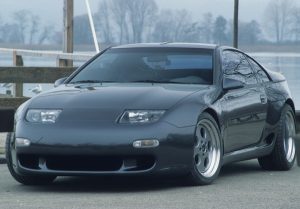
A lot of Bailey’s Strosek-style body kits for Nissan 300ZX were sold. I think Peter Filby might even have owned one. Maybe.
Not many people know that until fairly recently you could still buy Bailey’s Nissan kits in the USA via an ex-pat trading as V12 Sports. Not sure how many of these he sold as he sold full kits and individual elements such as spoilers separately. I think quite a few found homes.
Next for Paul Bailey was a Jaguar XJ-S-based body kit called the Monaco. He’d previously worked on an XJ-S project while at Glenfrome, as mentioned, so he had a regard for the car but always felt it was missing a trick.
Bailey’s Monaco was immediately accepted by the often sniffy Jaguar fraternity, but in the kitcar world, he was overshadowed by Paul Banham who at around the same time as the Monaco appeared announced his XJSS model, also a body conversion for XJ-S.
A shame really because the Monaco was a fine product and in addition to the Banham car it was also up against others such as the Lister XJ-S, Railton Claremont and Hyper XJ-S.
Bailey was quoted in 1999 as saying: “There’s no point in drawing something that can’t be built. My car turned out exactly as I drew it.”
There are several outside influences in the car’s styling with definite Wheeler-era TVR elements in there, a bit of DB7 and Jaguar’s XK8/R although Bailey’s original design pre-dated all of them them.
Bailey had originally intended to offer his panels in steel, even using Jaguar’s own ‘go to’ prototype company Park Sheet Metal but soon reverted to GRP instead. Customers could use any XJ-S model as a ‘donor’ although later cars were preferable, therefore 3.6- or 4-litre or even V12 like Bailey’s demo car. Indeed, Paul’s car features a V12 engine tuned by marque expert Rob Beere which had a 7.3-litre engine (XJR-S donor). A coupé or convertible XJ-S could be used for Monaco purposes.
A suspension kit had also been devised for Bailey by suspension expert, Rhoddy Harvey-Bailey, Compomotive produced bespoke split rim 17in wheels (the rears were monster 335 profile) and a revised, upgraded interior trim kit also lifted things.
Initially available in fully built guise with prices from around £24,500 before Bailey offered kit packages for £4250. Just eleven were sold, with the Sultan of Brunei is reported to own two of them.
Unfortunately, Paul Bailey suffered a very serious heart attack in 2001 and sold the Monaco project to a Texan engineering company, but the trail went cold, very quickly.
Bailey Monacos often come up for sale at the likes of Bonham or H & H auctions and recent ones have sold for about £40,000.
I think the last time I spoke to Paul Bailey was in 2004, while he was still recovering from his heart attack and I lost touch with him after that. All I can say is he was a hugely talented specialist car designer.
| Print article | This entry was posted by admin on July 20, 2023 at 10:30 am, and is filed under Uncategorized. Follow any responses to this post through RSS 2.0. Both comments and pings are currently closed. |
Comments are closed.








